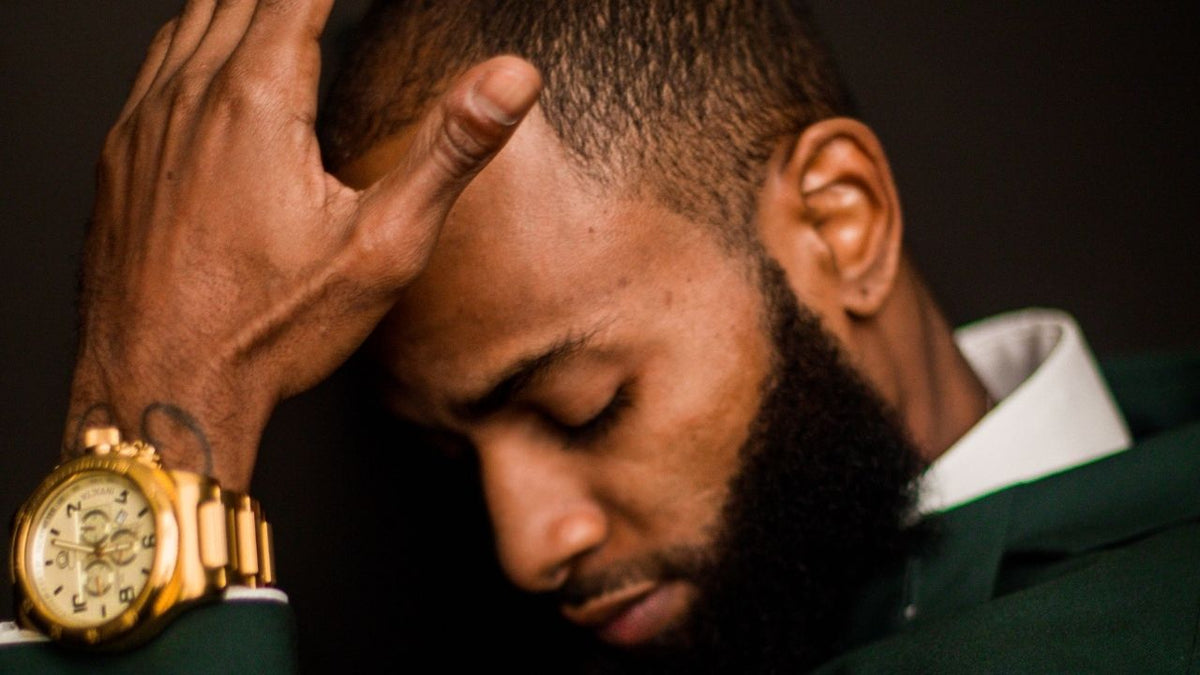
Natural Remedies for Male Pattern Balding
|
|
Time to read 4 min
|
|
Time to read 4 min
A gentleman named Terence hit me up on Facebook Messenger through our Black Men's Beard page. He shared with me that twelve months prior, he'd been shocked to find his hair thinning — at just 28 years old.
Like a lot of men, his thinning was taking place from his temples to his crown. And despite taking a boatload of biotin (a natural first step for a lot of guys), he didn't see any improvement. He was using hair fibers to cover it up, but that was only a temporary fix — not a long-term solution. He needed my help.
I told him: Hey man, I can see about helping you, but the first thing I need you to do is see a dermatologist.
If it's available to you, I always recommend seeing a dermatologist about your hair loss first. And that's because you need to determine these three things.
If your hair follicles aren't functional and you do have scar tissue, nothing can grow. That's why an initial visit to the dermatologist is so important. You need to know what you're working with!
After a few weeks, Terence hit me back up with his diagnosis: androgenic alopecia.
According to WebMD, you can typically spot androgenic alopecia — aka male or female pattern baldness — by "a receding hairline and gradual disappearance of hair from the crown and frontal scalp." It can even affect guys in their teens or early 20's.
Now that I had Terence's diagnosis, I was able to put together a hair growth strategy with complete clarity.
You could take the chemical route, which is one way to approach hair loss. We're talking about dutasteride and minoxidil, for example. But you have to be prepared for the possibility of harmful side-effects.
As a certified trichologist and someone who's also dealt with hair loss, I prefer a holistic approach. Here's why:
Hair loss is systematic, so you need a system to address it. Most people point to DHT, a sex hormone, as being the sole cause of progressive hair loss. But when you dig deeper, you uncover a litany of triggers. You don't just need one tool, you need multiple. That's the idea behind the holistic mindset — acknowledging that everything works together.
With that in mind, let's take a look at three of my go-to methods for treating male pattern baldness — without any nasty chemicals.
A botanical is a substance derived from a plant and typically used as an additive for cosmetics or health products. For hair loss specifically, you want to look into saw palmetto, which is a natural DHT blocker, and rosemary, which is an antioxidant. But that's just to name a few.
When you look at the ingredients in our hair repair system, you'll notice several other botanicals. All of these ingredients work together harmoniously to create a healthy scalp environment. Because if the scalp environment is not healthy, hair will not grow.
Botanicals are how we address hair loss topically. Now let's talk how we address it internally.
Our system is naturally derived from a proprietary blend of Ayurvedic herbs and peppermint oil to support blood flow to the scalp and activate new growth.
Nutraceuticals are foods that are believed to have medicinal benefits, like ashwagandha and turmeric. Nutraceuticals get to the root cause of hair problems — the internal state of the body. Because caring for the scalp is only one part of the equation.
So when you're looking at stress-induced hair loss, consider Ashwagandha. Ashwagandha protects you by building your body's resilience to stress. It also helps you recover from stress.
Derma rolling is a technique where you take a facial tool called a derma roller — which looks like a miniature paint roller with hundreds of tiny needles on it — and you gently roll it across the skin. This revs up your skin's rejuvenation process, flooding your skin (and follicles) with nutrients and oxygen. This alone stimulates hair growth. But when you use derma rolling in conjunction with your MY Hair Repair Serum, the serum becomes even more effective because it's able to saturate your scalp more easily.
Derma rolling is a microneedling technique that's best done by a professional. But with proper technique and safety protocols put in place, you can use a derma roller at home to boost hair growth.
What are some other things that I can do to treat hair loss?
Make sure you're getting enough sleep, managing stress as best you can, and encouraging blood flow through exercise.
How long until I see progress in my hair growth?
When you're on the road to recovery, the sweet spot is between three and six months. That's where you start to really see some progression. Your progress also depends on your health, your habits, and how long you've been experiencing hair loss. If you've been experiencing hair loss for quite a while, growing it back can take longer than six months. The quicker you could get to it, the better.
Treating hair loss is all about being proactive about the things that you have control of. So be realistic about where you're at and what your hair loss triggers are. (Go see a dermatologist!) From that point of clarity, you can begin to turn that ship around.
Explore natural remedies for hair loss that can help manage male pattern hair loss effectively. Discover home remedies for hair growth, including scalp massage for hair growth and essential oil blend for hair growth. Learn about vitamins for balding that can support your journey.

